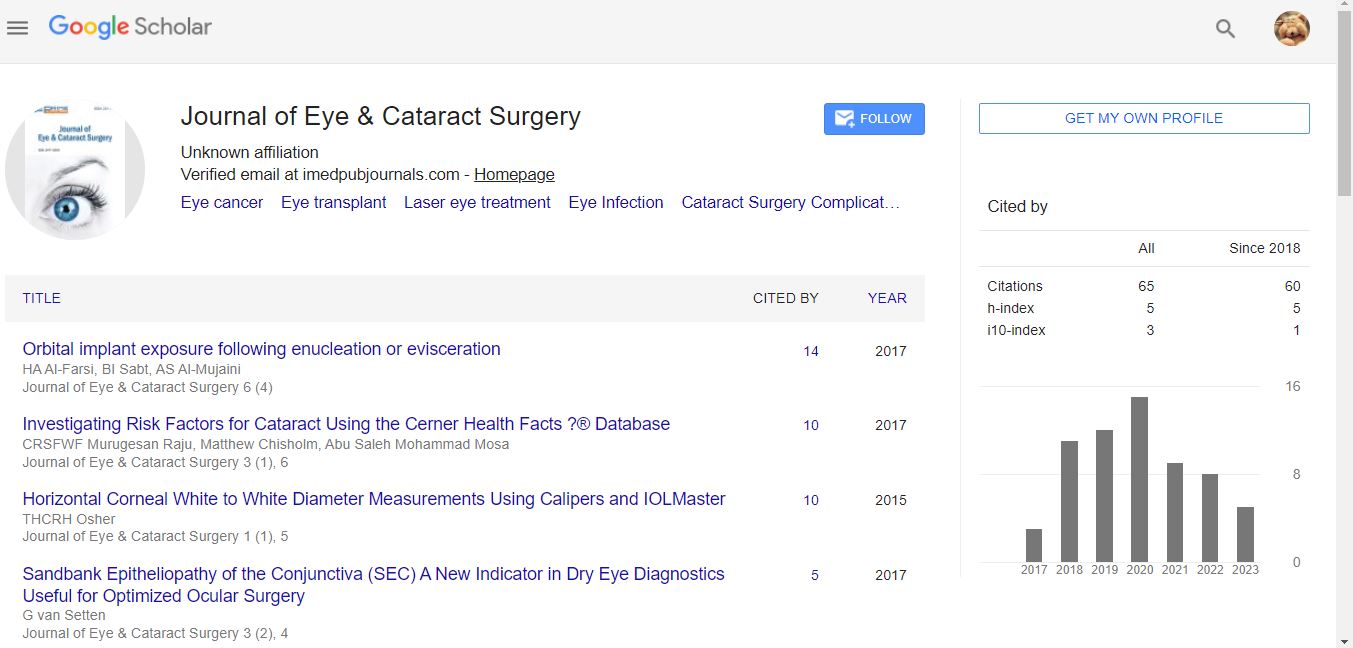Commentary - (2024) Volume 10, Issue 3
The Advancements and Benefits of Gas Permeable Contact Lenses
Roberts Elena*
Department of Optometry, University of Vision Sciences, USA
*Correspondence:
Roberts Elena,
Department of Optometry, University of Vision Sciences,
USA,
Email:
Received: 02-Sep-2024, Manuscript No. IPJECS-24-21684;
Editor assigned: 04-Sep-2024, Pre QC No. IPJECS-24-21684 (PQ);
Reviewed: 18-Sep-2024, QC No. IPJECS-24-21684;
Revised: 23-Sep-2024, Manuscript No. IPJECS-24-21684 (R);
Published:
30-Sep-2024, DOI: 10.36648/2471-8300.10.3.24
Description
Gas permeable contact lenses have revolutionized the field
of vision correction, providing an effective and comfortable
option for millions of individuals with refractive errors. Unlike
soft contact lenses, which are made of hydrophilic materials,
lenses are crafted from rigid materials that allow oxygen to pass
through to the cornea. This increased oxygen transmission is
particularly beneficial for individuals who wear their lenses for
extended periods or engage in activities that may limit airflow to
the eyes. Additionally, offer excellent optical clarity due to their
rigid structure. The consistent shape of lenses helps maintain
their position on the eye, allowing for stable and sharp vision.
This is especially advantageous for individuals with higher levels
of astigmatism or irregular corneal shapes, as can be customized
to correct these specific vision problems more effectively than
standard soft lenses. Many practitioners find that provide
superior visual acuity, which can enhance overall quality of life
for wearers. Fitting gas permeable lenses requires a thorough
examination by an eye care professional, who will evaluate
factors such as corneal curvature, pupil size, and tear film quality.
The fitting process is critical, as the lens must align properly with
the eye to ensure comfort and optimal vision can be customized
in terms of curvature, diameter, and thickness to suit individual
needs, making them a versatile option for a variety of patients.
While the initial fitting may take more time compared to soft
lenses, the long-term benefits often justify the effort. Care and
maintenance of gas permeable contact lenses are crucial for
ensuring their longevity and maintaining eye health. Users must
clean and disinfect their lenses daily to prevent the accumulation
of debris and microorganisms. Specialized care solutions are
available, and patients should be educated on proper cleaning
techniques. Regular follow-ups with an eye care professional are
also important to monitor the fit of the lenses and the health of
the cornea. Gas permeable lenses also have an added advantage
for individuals who are involved in sports or active lifestyles.
Their durability makes them less prone to tearing or damage
compared to soft lenses, providing a reliable option for those
who engage in physical activities. Additionally, lenses do not
absorb water, which minimizes the risk of blurry vision caused
by sweat or humidity. Emerging technologies are continuously
improving gas permeable lenses, with innovations such as custom
lens designs and specialized coatings that enhance comfort
and performance. Orthokeratology, a specialized application
lenses, involves wearing these lenses overnight to temporarily
reshape the cornea, allowing individuals to enjoy clear vision
throughout the day without the need for glasses or contact
lenses. This approach is gaining popularity, particularly among
children and teenagers. In conclusion, gas permeable contact
lenses represent a significant advancement in the field of vision
correction. With their superior oxygen permeability, excellent
optical clarity, and customizable options, lenses offer a versatile
solution for individuals seeking effective and comfortable vision
correction. As technology continues to evolve, the potential
for gas permeable lenses to improve eye health and quality of
life will only increase. By educating patients and encouraging
regular follow-ups, eye care professionals can ensure that users
enjoy the many benefits of these innovative lenses, paving the
way for healthier and clearer vision.
Acknowledgement
None.
Conflict Of Interest
None.
Citation: Elena R (2024) The Advancements and Benefits of Gas Permeable Contact Lenses. J Eye Cataract Surg. 10:24.
Copyright: © 2024 Elena R. This is an open-access article distributed under the terms of the Creative Commons Attribution Li�cense, which permits unrestricted use, distribution, and reproduction in any medium, provided the original author and source
are credited.

